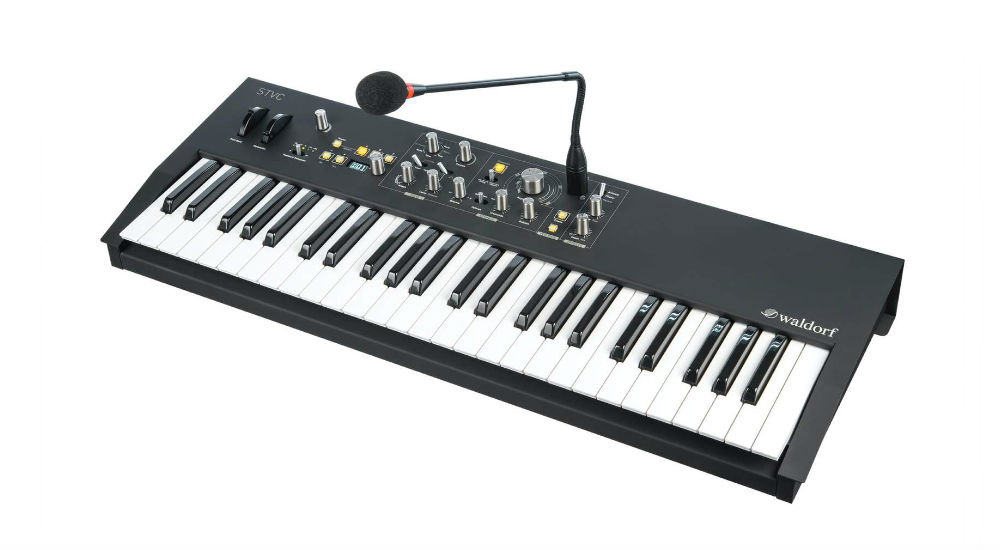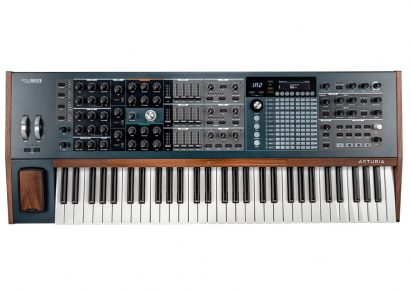Link Audio | linkaudio.com.au | Expect to pay: A$1,499
String synthesisers have always been viewed with a bit of a contentious eye by keyboard purists. Introduced in the ‘70s, they formed a middle ground between a digital organ and a regular keyboard, allowing groups to embellish their music with soaring tones to emulate the crescendos of a live string quartet. While boasting a remarkably unique sound, their association with the rise and fall of disco saw them become seen as a bit of a fad in many musical circles, and when poly-synths were introduced to the masses in the early ‘80s, it looked like it was all over for the string synth.
However, we all know that history repeats itself, and now, Waldorf have launched their own take on the string synth with the STVC. Built in Germany and featuring a beautiful 49 key Fatar keybed, two synth engines, inbuilt effects and even a vocoder, the STVC is by all means a string synth for the modern world. It’s also powered via USB, has MIDI I/O, patch storage and a nifty line input to allow for external processing, which is an awesome trick for creating unique sounding gated sequences in tandem with the vocoder.
Catch up on all the latest music gear reviews here.
Interestingly enough, it’s not the first time Waldorf have dabbled in string synths: their Streichfett module has been available for a while now and is considered as an essential for anyone seeking lush tones on a budget. Sonically, the STVC and Streichfett share many similarities, and even feature a near-identical set of controls. However, the STVC does expand on the sound of its smaller sibling by adding a few extra tweaks, which go the distance to ensure the STVC is much more than just an overblown Streichfett clone with a vocoder attached – although I do wish they made the screen on this one a bit bigger.
At a fundamental level, the STVC lets you layer two independent sound engines to create distinctive tones, with each engine also being able to be played on its own by panning the central balance knob. The String engine features Violin, Viola, Cello, Brass, Organ and Choir tones, all of which draw inspiration from those classic disco machines of yore and can be tweaked via Crescendo (attack) and Release knobs.
In isolation, the String engine is incredibly lush and surprisingly versatile, covering everything from nasal sawtooth strings and organs to pulsewidth pads. The Crescendo knob, a nod to the classic Solina string machine, is a thoughtful touch, and although the Violin and Choir tones are notably thinner than the rest of the bunch, the Chorus and Ensemble effects let you beef them up beyond belief for pads that soar sky high. This section is perfect for suspenseful strings and moody ambiance alike, and there’s also a sweet spot around the Cello/Organ mark that gives you a beautiful Beach House sounding organ: dream pop perfection.
Moving on, the Solo engine of the STVC plays host to seven distinct tones: Bass, Electric Piano, Clavinet, Synth and Pluto, as well as the newly added Mono and Full sounds. There’s also two envelope types to choose from, an attack and decay/release control and a tremolo, which was quite weak to my ears and paled in comparison to the hefty warble of Phaser or the LFO-like Animate effect. The Bass patch is a big, fat polyphonic square wave sound that’s great for chords and low-end alike, while the Synth and Pluto tones bear a unique timbre that’s perfect for psychedelic swirls and sizzling pads. Lingering on the lower end of the attack knob will also unlock some very clicky sounds not unlike that of a percussive organ, which varies in usefulness depending on how you’re using it.
While there’s nothing immediately remarkable about the Electric Piano or Clavinet sounds, they reveal their potential when cleverly blended with the String section, rewarding you with shiny ambient drones and delicate transient tones. On a side note, adding a splash of reverb to any of these sounds makes all the difference: it’s got a beautiful depth, and a good way to warm up those icy digital tones.
The two new tones on the Solo section also deserve a shout of their own. The Full tone is essentially just a stacked unison sound, which is a killer way to really thicken up the low end of some of those brass or string sounds, and can hold its on as a lead too. On the other hand, the Mono patch is absolutely glorious: it’s got such a gorgeous sound that’s rich with nuance, and really springs alive for lush, gliding leads.
As beautiful as this tone may be, it’s also frustrating in the sense that the STVC is totally void of a filter cutoff or resonance control, which I feel slightly detracts from the versatility of this sound and the unit overall: if only they’d done away the tremolo and added this feature instead. However, like all classic string machines, the STVC’s limitations do yield benefits of their own, and it’s one of the most rewarding and immediately simple units I’ve had the chance to review in a long time. Plus, the feel of that Fatar keybed is next to none – it’s easily among the nicest feeling keyboards I’ve ever encountered on a synth in this price range.
Now, the vocoder. With 256 band sound quality, it’s quite a nice sounding vocoder with a surprising level of diction on offer, and the Waldorf-supplied goose neck mic is more than adequate for playing around or live performances. Rolling through the String section unlocks a range of spooky dissonant tones and classic robot voices, while the Solo section lets you get a bit thicker and gooier to cut through with the funk. It’s also nice to be able to split the sections of the synth, and play a left-hand bass with a right-hand vocoder sound. Given that vocoder is such a niche tool to start with, it’s difficult to say that this is a versatile feature, but it’s certainly a cool addition to a unit indebted to an age where vocoder was more the sound of the future and less ‘hey that sounds like Daft Punk’. Nevertheless, you’ll use it because it’s there, and it might even take you on a surprising sonic odyssey that leads you to discover a brand new sound: after all, wasn’t that the point of the synthesiser in the first place?
Aside from some minor gripes, I can’t see any reason to sling mud at the STVC whatsoever. Its build quality, sound and feel is next level, and the ability to isolate or blend both engines makes for a synth that’s a lot more versatile than initially apparent. It functions as both an upgraded Streichfett and a faithful pastiche to the disco machines of the late ‘70s, yet there’s enough under the hood to give it quite a psychedelic timbre that’s also suited to the future. With the STVC, Waldorf once again prove that they are masters in their craft, bridging classic and contemporary to produce a limitlessly rewarding synth in a field of its own.

